Lebanese Fattoush Salad is a traditional Middle Eastern salad made with low-carb crispy tortillas, seasonal fruit and vegetables and bright herbs tossed with a zesty sumac Mediterranean salad dressing. It's a delicious simple chopped salad that is so easy to make, but so incredibly good.
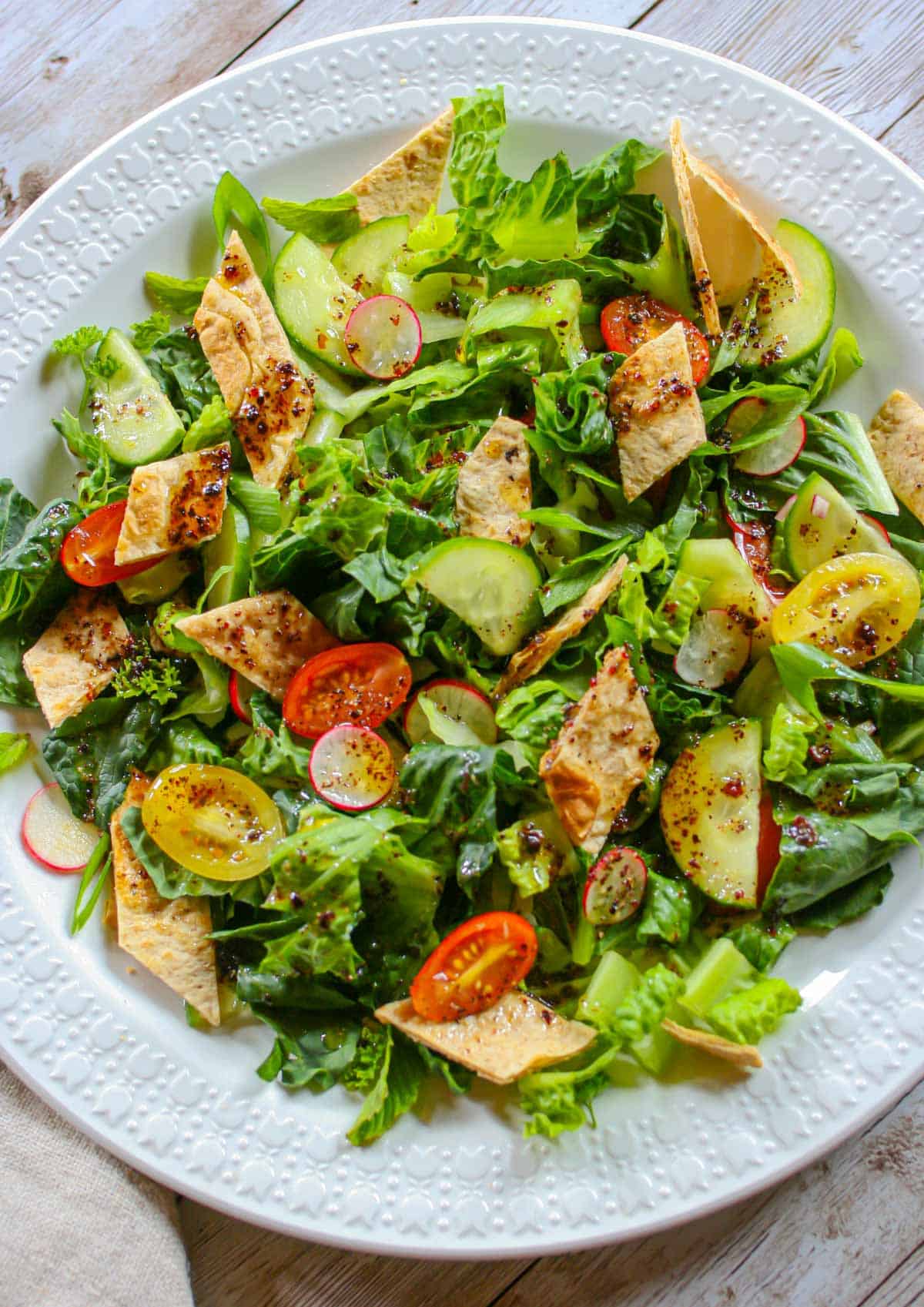
Jump to:
This Easy Lebanese Fattoush Salad is in my top three favorite salads, one of which is this Mediterranean Cucumber and Tomato Salad with crisp veggies and creamy feta cheese. Both can use this robust Sumac Dressing for classic Mediterranean flavor.
I don't eat a lot of gluten, but I've found that keeping some low-carb tortillas or flatbread around is great for a treat now and then. They're especially good for replacing traditional pita bread in this recipe.
Why you'll love this recipe
- Simple and healthy – made with seasonal ingredients, it's so easy, versatile and nutritious
- Easy meal prep – simply chop your veggies, whisk up the quick dressing and toast the tortillas
- Light but monumentally flavorful – it has a bright flavor and tastes like springtime, with a tangy, sumac dressing
- Special diet friendly – this is a keto-friendly, low-FODMAP salad and is easy to make paleo and Whole30 - simply replace the tortillas with recommended options, below
What is Fattoush?
Fattoush is a popular dish in Middle-Eastern (and Mediterranean) cuisine. Even though there are many variations, fattoush contains a few signature ingredients that are common among all recipes: pita slices (or scraps), fresh garden vegetables, herbs, sumac and a bright, lemony dressing.
Fattoush is essentially 'fried bread salad' and is believed to have originated in Lebanon. In Arabic, 'fattoush' is derived from the word "fatteh", a dish in which historically, stale flatbread was used as a base. Additional ingredients will vary depending on the season, which accounts for several versions of this recipe throughout the Middle East and Mediterranean.
Traditionally, fattoush is tossed with a simple lemon dressing and mint. This combination produces such a beautiful flavor – it’s light, refreshing and savory all at the same time. If you don't have any lemon, replace it with lime or orange juice.
There are many spellings for this Lebanese salad. All are pronounced 'fuh-toosh'. The most common spelling is actually 'fattoush'.

Ingredients
There are no rules when it comes to what vegetables you can use, but there are a handful of ingredients you’ll find in a more traditional version:
- Lettuce – use romaine, iceberg, spring greens or even spinach
- Parsley – finely chopped, it adds a fresh, vibrant flavor. It also contains many nutrients.
- Mint – adds a refreshing level of complexity
- Tomatoes – commonly found in fattoush salads. Most often you’ll find larger varieties such as vine tomatoes or beefsteak, but I enjoy using grape or cherry tomatoes.
- Radishes – add a spicy, peppery, crisp flavor
- Green onions – have a mild onion flavor and are perfect for a low-FODMAP salad. You can also use red or white onion if you prefer.
- Cucumbers – commonly found in many Middle Eastern and Mediterranean salads. English or Persian cucumbers are best.
- Low-carb Tortillas or pitas – use your favorite low-carb or gluten-free variety
- Olive oil – for toasting the tortillas or pita
- Sumac dressing – a tangy, savory, traditional dressing
- Sumac spice – for garnish
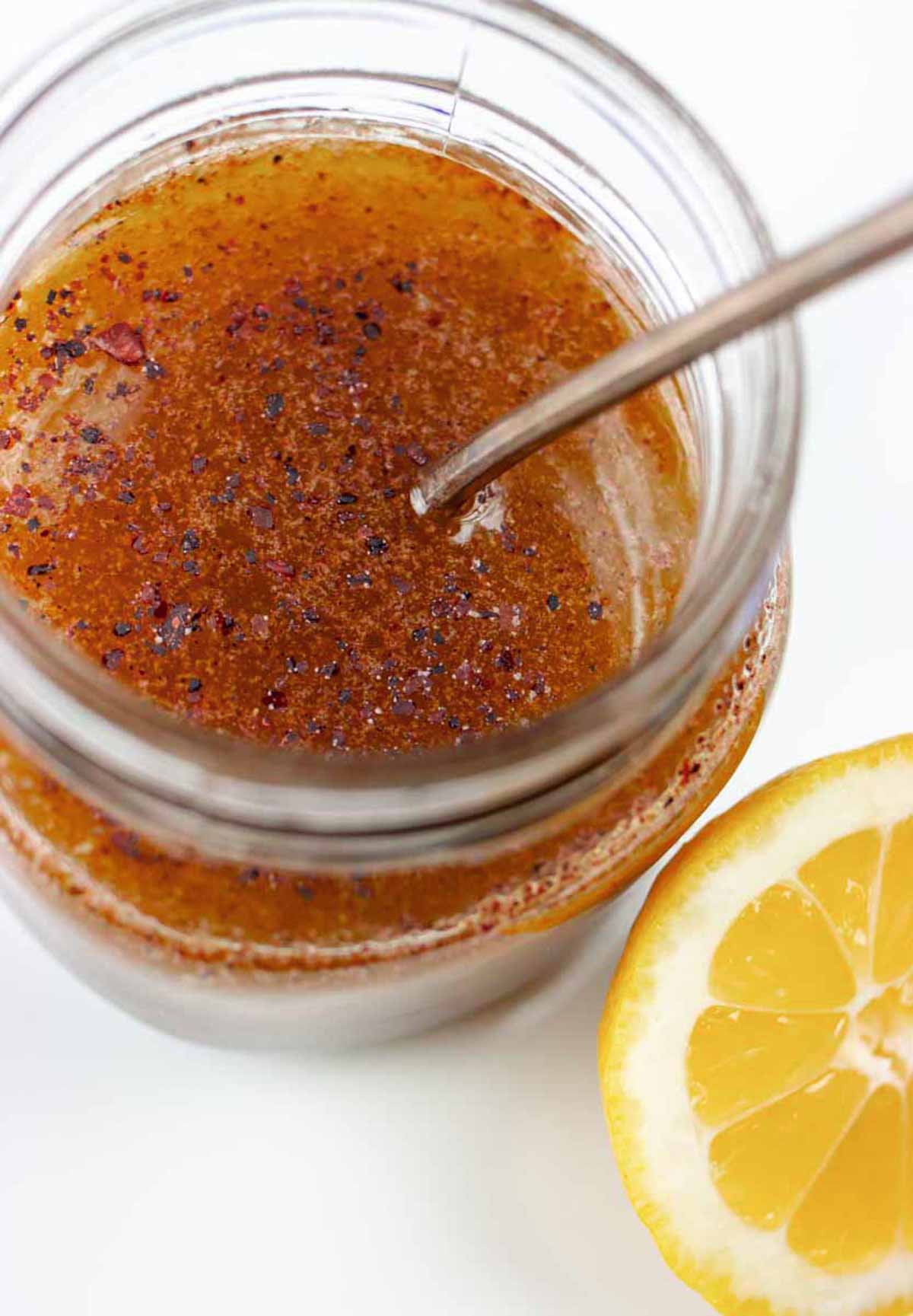
Dressing fattoush salad
I love this zesty Sumac Dressing as a fattoush salad dressing. You can make it as a vinaigrette or as a creamy version with tahini. Sumac gives the dressing a distinct and complex flavor.
Traditionally, fattoush dressing contains pomegranate molasses, which is fruity, rich and sweet, but is also high in carbs. Since pomegranate molasses isn’t a keto or low-carb friendly ingredient, I use this sumac dressing that gives it a bit of tang and citrus.
What is sumac?
Sumac is a spice that is common in Middle Eastern recipes. It has a bright red color and a tart flavor similar to lemon, but not quite as sour. Cooking with sumac brings out the natural flavors in food, similar to salt. Its taste is sour and slightly sweet, with an astringent punch.
Instructions
- Make the dressing – whisk all of the sumac dressing ingredients together in a small bowl or shake in a mason jar until thoroughly combined. You can make the dressing in a blender or food processor, which helps to emulsify the ingredients and keep them from separating.
- Chop the vegetables – cut small enough so every bite is covered in the delicious dressing
- Prepare the tortilla – slice the tortilla in desired shapes (square, triangles or strips), toss in olive oil and fry on medium heat until just browned and crispy
- Assemble the salad – combine the veggies together in a large bowl and add the crispy low carb pita tortilla chips. Drizzle with the dressing and toss.
- Serve – garnish with freshly ground pepper and an additional sprinkle of sumac
What to use instead of tortilla
Even though fattoush is referred to as a ‘bread salad’, it can certainly be left out. There are delicious alternatives to add that satisfying crunch and keep it a gluten-free fattoush:
- Crumbled pork rinds – these are a crisp, keto-friendly salad topping
- Nuts – a crunchy, healthy alternative. Try my Sugar-free Candied Pecans, some pine nuts, slivered almonds or walnuts.
- Use gluten-free options – gluten-free croutons or toasted gluten-free tortilla strips from gluten-free almond flour tortillas
- Crispy bacon – because bacon goes with everything!
How to store
Store the salad and dressing in the refrigerator separately and only dress the salad before serving to prevent the greens from wilting.
Keep the undressed salad in the refrigerator for up to 4 days, and the dressing for up to 2 weeks.
Variations and add-ins
- Cheese – feta, parmesan, or even a salty dry cheese such as cotija
- Protein of choice – create a hearty dinner salad by adding your favorite protein: chicken, beef, spiced lamb, or shrimp. Make a fattoush chicken salad with leftover Convection Roasted Chicken or even Thanksgiving turkey leftovers.
- Nuts – if you want some extra crunch, add your favorite nuts – Homemade Candied Pecans or toasted pine nuts are my favorites
- Herbs – add chives, edible flowers, fresh thyme, savory or roasted garlic (omit for low-FODMAP)
- Fruit, vegetables and berries – include whatever vegetables or fruits that suit your fancy, like bell peppers, carrots and even fresh summer berries
Serving suggestions
Fattoush is a very versatile salad. Serve alongside meats like this Smoked Leg of Lamb, poultry, seafood (it's a beautiful complement to Air-Fryer Halibut), and soups like Turkey Lentil Soup or phenomenal Gazpacho Manchego. Try customizing with some add-ins (above) to create a stand-alone dinner salad.
FAQ
Of course! Preheat the oven to 350°F, toss the strips in oil and bake for 8-10 minutes, flipping halfway through. Bake in the air fryer at the same temperature for the same amount of time.
Yes! Combine the salad ingredients, make the dressing and crisp the tortilla strips. Then dress the salad right before serving. Otherwise, the acidic dressing will wilt the leafy greens, and it won't keep well overnight.
Both Lebanese salads have fresh ingredients and are very popular. Tabbouleh uses parsley as its main ingredient, finely chopped with onion and tomatoes. Most recipes include cracked bulgur and a simple dressing of olive oil and lemon juice.
Fattoush includes a medley of colorful vegetables, topped with crisp toasted pita, and tossed with a flavorfull Mediterranean dressing that most often includes sumac.
Yes! My Sumac Dressing includes all FODMAP-friendly ingredients.
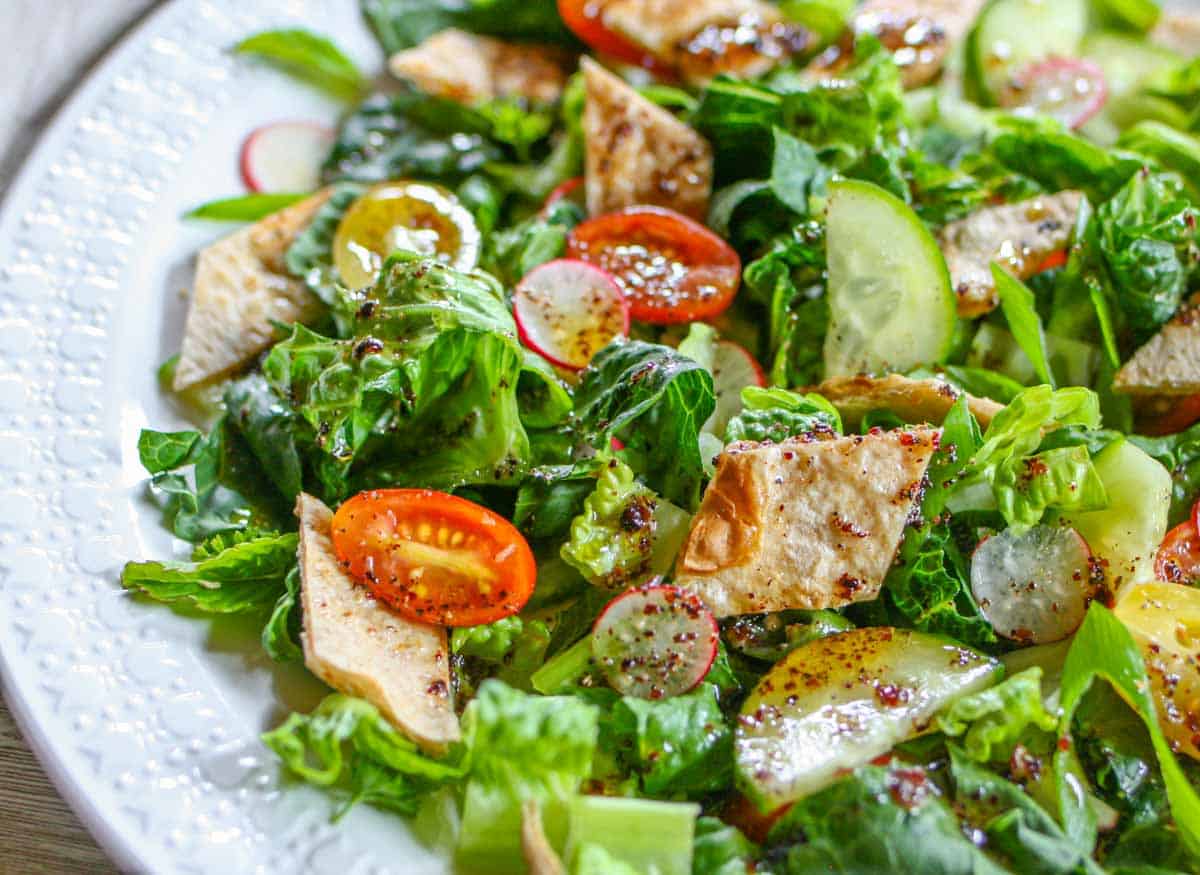
Did you make this recipe? Let me know how you liked it by giving a star rating and leaving a comment!
📖 Recipe
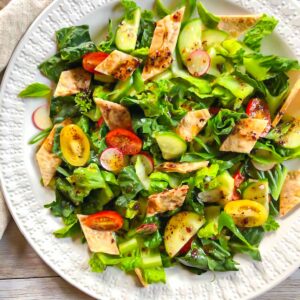
Lebanese Fattoush Salad Recipe
Ingredients
For the salad
- 1 head romaine lettuce (large head - chopped)
- 1 cucumber (medium - sliced)
- 2 green onions (chopped)
- ¼ cup parsley (finely chopped)
- 2 tablespoons mint (chopped)
- 5 radishes (sliced)
- 12 cherry tomatoes (sliced in half, or 2 large tomatoes, chopped)
- 2 low-carb tortillas (sliced into pieces)
- 1 tablespoon olive oil
- ¼ cup Sumac Dressing (or to taste)
- Sumac (for garnish)
Instructions
Make the Tortilla chips
- Add 1 tablespoon olive oil to a large skillet over medium heat.
- When oil is hot, add the tortilla pieces and cook for about 5 minutes, flipping often. Toast until they're crisp and slightly browned.
For the salad
- In a large bowl, combine the lettuce, cucumber, green onion, parsley, mint, tomatoes, and radish and toss.
For the dressing
- Combine all ingredients for the Sumac Dressing in a small bowl and whisk until thoroughly combined. Or, add all ingredients to a mason jar and shake vigorously (my preferred method). The dressing can also be made in a blender or food processor for a more emulsified dressing.
Assemble
- Pour on the dressing and toss. Add the crisped tortilla chips and toss again.
- Plate the salads and garnish with a sprinkle of sumac. Enjoy!
Notes
How to store
Store the salad and dressing in the refrigerator separately and only dress just before serving to prevent the greens from wilting. The undressed greens can be kept in the refrigerator for up to 4 days. The dressing can be kept in the refrigerator for up to 2 weeks.Variations and add-ins
- Cheese – feta, parmesan, or even a salty dry cheese such as cotija
- Protein of choice – create a hearty dinner salad by adding any protein you like: chicken, beef, spiced lamb or shrimp. Make a fattoush chicken salad with leftover Roast Chicken or even Thanksgiving turkey leftovers.
- Nuts – add your favorite nuts – Homemade Candied Pecans or toasted pine nuts are my favorites
- Herbs – add chives, edible flowers, fresh thyme, savory or roasted garlic (omit for low-FODMAP)
- Fruit, vegetables and berries – add whatever vegetables or fruits that suit your fancy, like bell peppers, carrots and even fresh summer berries.
Nutrition
*Net carbs = carbohydrates - fiber
Nutritional information is an estimate, calculated using online tools and does not include optional ingredients unless otherwise indicated.

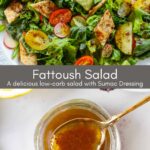


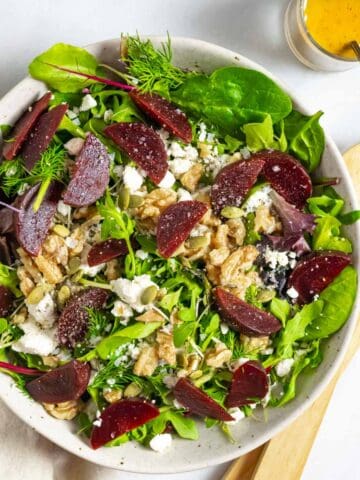
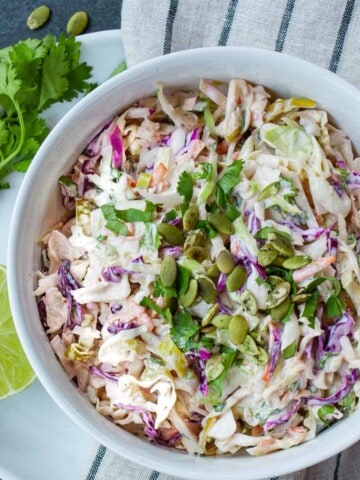

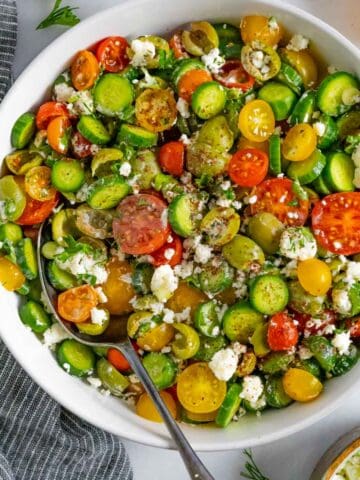
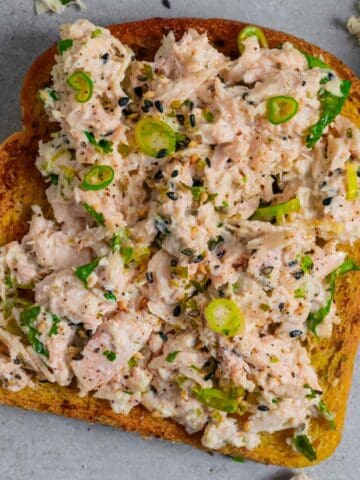

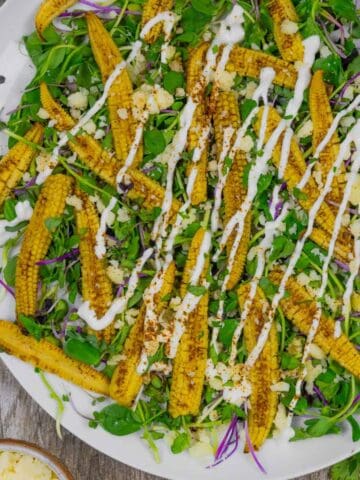
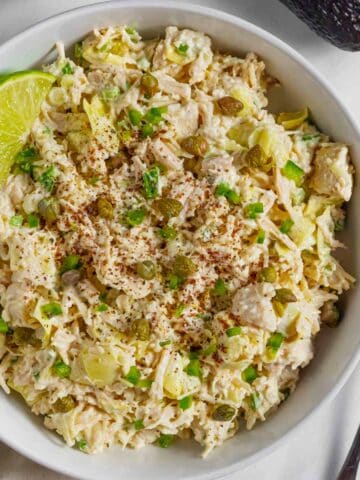
Tracey Hatch-Rizzi says
The flavor of the mint with sumac really makes this salad come alive!